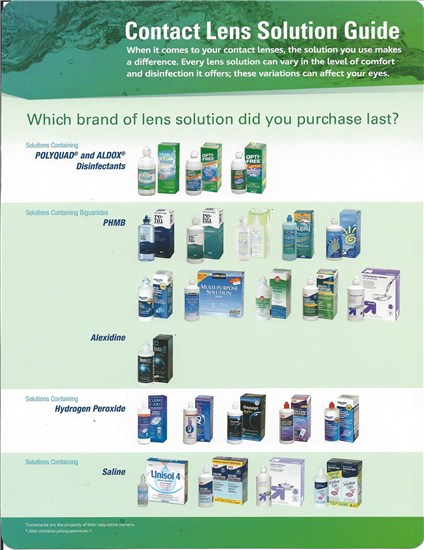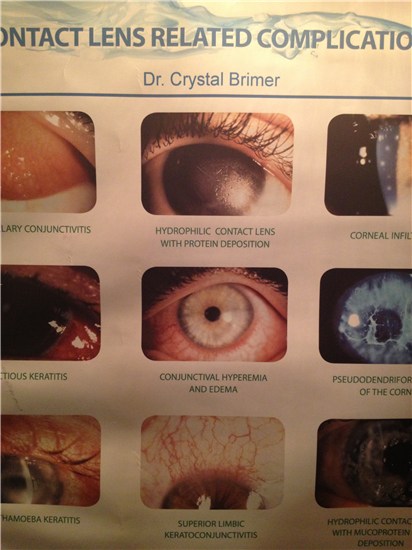By Crystal Brimer, OD

Explain to patients that preservatives found in certain contact lens solutions can negatively affect their eyes and decrease wearing comfort. Be the recommender and steer patients to specific, high-quality contact lens solutions that make long-term contact lens wear more likely.
Wilmington, NC
Southern College of Optometry, class of 200
Single location and six support staff shared by one MD and one OD
3, 600 comprehensive examinations performed annually in the clinic.
35-40 percent of patients contact lens wearers
Many ODs provide patients with a recommendation for a specific contact lens solution and offer a complimentary sample to get them started. But not enough of us educate our patients about the differences between solutions. Recent findings from the FDA showed that uptake of preservatives could be problematic and that there could be reduced disinfection efficacy with some lens and lens care combinations. This is important information to consider when we recommend a solution to our patients–especially when discomfort has been reported as the leading cause of contact lens dropouts.1 We have the opportunity to impact patient success by making a strong recommendation for contact lens care.
The FDA research found that the uptake of the polyhexamethylene biguanide (PHMB) solution (0.0001%, six-hour soak) caused a reduction in the PHMB concentration and reduced disinfection efficacy against both Staphylococcus aureus1 and Fusarium solani.2 When disinfectant is released from the lens, it may have a negative effect on human corneal epithelial viability and barrier function.3,4 Currently 50 percent of patients are using PHMB-based solutions, many of which are generic or store-branded products.6
The Value of Contact Lens Patients—and the High Cost of Losing Them
Patients who wear contact lenses are highly valuable to your practice. Said another way, contact lens dropouts are very costly.
How costly? According to the Management & Business Academy’s Best Practices of Contact Lens Management (p. 28), a typical OD practice with $500,000 in revenue has 1,200 of its 4,000 active patients wearing contact lenses. If 10 percent or 120 contact lens wearers drop out, that represents a loss in revenues of $31,680 in subsequent years. That figure increases the larger the practice.
Other factors: Contact lens patients tend to visit a practice more often than spectacles-only patients (18 months vs. 24 months), a factor accelerated by annual supply sales. Further, contact lens wearers also buy spectacles and premium sunwear–and more so if you recommended these optical goods.
Action Point: Ask contact lens patients, “Are you comfortable in your contact lenses?” Patients who drop out of contact lens wear (often without informing their doctor) usually do so because of discomfort–the very issue that ODs are well-equipped to address with new lens materials, comfort drops, dry eye solutions and lens care products and instruction. —ROB editors
The FDA also studied a solution with Polyquad/Aldox preservatives and, by contrast, found that in the presence of a lens, the residual concentration of Polyquad/Aldox preservative was reduced only slightly over time, and storage with the lenses did not adversely affect biocidal efficacy.5
While only one solution of each preservative type was studied by the FDA, here is how I let my patients know that all solutions are not the same, and what effect this may have on their lens wearing experience.
Different Solution Means Different Components
First and foremost, patients should know that all solutions are not the same and that specific formulations differ, even when a common preservative is used. I explain that a frequently used preservative found in some contact solutions can be absorbed into the lens. And because we don’t want extra chemicals in the eye, I am recommending a specific solution with a different preservative that has less absorption into the lens. This way the disinfectant remains in the solution, where it needs to be, in order to kill harmful bacteria. It also helps the tear film do its job of keeping you more comfortable.
Use Images to Educate on the Difference
I have a series of photos showing different levels of corneal staining and other contact lens complications. I show it to patients when I feel there is a need for further education or motivation, especially if I suspect they are non-compliant with their lens care or lens wear. For some, I may also mention the FDA research regarding reduced disinfection efficacy of certain lens and solution combinations.
Use Printed and Electronic Materials to Offer Solution FAQs
For patients using generic solution, I may use a grid showing the average amount of solution-induced corneal staining caused by specific combinations of lenses and solutions. We have iPads in the office available for patient use, so it’s easy to pull up information and walk them through it electronically or hand it over as a printout. Adding information to your web site or offering downloadable brochures highlighting the differences in the ingredients of various solutions is another great way to educate your patients.

Dr. Brimer uses this chart listing the different categories of solutions to educate patients on the differences between different solutions.
Explain Why the Solution You Recommend Will Help Keep them in CLs
As stated earlier, discomfort is the leading cause of contact lens dropouts.1 I believe that solution choice plays a big role in patient comfort and their likelihood of success in the face of compromising conditions. Because patients don’t need permission to drop out, we often don’t realize it’s happening. In light of that, we need to be more proactive in putting systems in place ahead of time, to better prepare them to meet comfort challenges throughout the year. We can do that by not just prescribing the lens, but by strongly recommending a lens care system, as well. If they use a solution like Opti-Free PureMoist that can improve their comfort even when nothing’s wrong, I’m confident it will help in the face of lens-related dryness. Or if I have a patient with extreme seasonal allergies or preservative sensitivities, I recommend ClearCare. Using ClearCare usually enables them to continue wearing their lenses year round, which is a big win for many patients.
Make It Easy for Patients to Remember Your Solution Recommendation
I keep the sample kit in the exam room. Before they leave, I pull the bottle out of the box and hand it to them saying, “This is the solution I want you to use.” I then tear the top tab off the box and hand it to them saying, “Put this in your wallet now; this is what I want you to buy.” I turn the OPTI-FREE PureMoist box over and show them the picture on the back, “See how this solution envelops the lens with moisture? It works well with the lenses I have prescribed you and it will help you wear your lenses longer and more comfortably each day.”
I also have a small recommendation pad that I created to use for every contact

Dr. Brimer shows this chart of eye complications related to contact lens wear to patients to stress the importance of following the recommended lens care regimen.
lens patient. At the top it has the solution I am recommending and what it is used for. Under that are check boxes that allow me to document how many hours per day I want them to wear their lenses, when to throw them away, and when to return to the office. There is also a disclaimer about safe contact lens wear and a place for both the patient and dispenser/doctor to sign. I find that patients usually appreciate having everything spelled out so they don’t have to remember the details. Having the patient sign a copy provides chart documentation, but it also gives them a sense that contact lens wear does carry a certain amount of risk and it is important that they follow my instructions.
Have Contact Lens Technicians Reinforce Your Message
Proper contact lens cleaning protocol is posted and the technician discusses it with all contact lens patients, even experienced wearers. This is done during the work up, after asking how they care for their lenses. We also request that our patients bring in all their eyecare products so there’s no question of what they’re using to clean their lenses, and to give us an idea about their hygiene and compliance. The technicians are trained to point out: “This is what the doctor has recommended for you. There is no store brand equivalent of this product.” We try to repeat the recommendation several times throughout their contact lens exam, because we find that established wearers are even more likely than new wearers to buy generic solutions. Ultimately, the more we can influence a patient’s lens wear and care regimen, the more comfortable and safe that patient will be.
Educate Patients on Best Solutions: Action Plan
Hand patients a bottle of the solution you recommend. Tear the top off the box off and ask them to put it in their wallet as a reminder of what to buy. If you only have a few seconds, at least be very directive so the patient knows they are getting an actual recommendation and not just a free sample.
Have staff go over posted recommendations for contact lens care with every patient, even experienced wearers.
Have front desk staff ask patients to bring in all solutions and supplies they use to care for their contact lenses. It allows us to open the conversation regarding lens care. I give patients a strong recommendation for lens care, telling them what to use, max wear time, disposal and follow-up requirements.
Show patients photos of corneal staining and CL complications. Explain how this might impact their eye health and wearing comfort.
Compare the extra cost to something expendable that they are already spending their money on like soda, coffee or a Big Mac.
References: 1. Rumpakis J. New data on contact lens dropouts: An international perspective. Rev Optom. 2010:147(1):37-42.
1. Shoff ME, Lucas AD, Brown JN, et al. The effects of contact lens materials on a multipurpose contact lens solution disinfection activity against Staphylococcus aureus. Eye Contact Lens. 2012 Nov;38(6):368-73.
2. Clavet CR, Chaput MP, Silverman MD, et al. Impact of contact lens materials on multipurpose contact lens solution disinfection activity against Fusarium solani. Eye Contact Lens. 2012 Nov;38(6):379-84.
3. Chuang EY, Li DQ, Bian F, et al. Effects of contact lens multipurpose solutions on human corneal epithelial survival and barrier function. Eye Contact Lens 2008;34:281–286.
Related ROB Articles
Lead the Discussion to Improve Contact Lens Care Compliance
Improve Compliance and Comfort: Three Conversations that Work
Retain Profitable Contact Lens Patients with Good Lens Care Recommendations
Crystal Brimer, OD, owns an independent practice is Wilmington, NC. To contact her: drbrimer@crystalvisionservices.com























